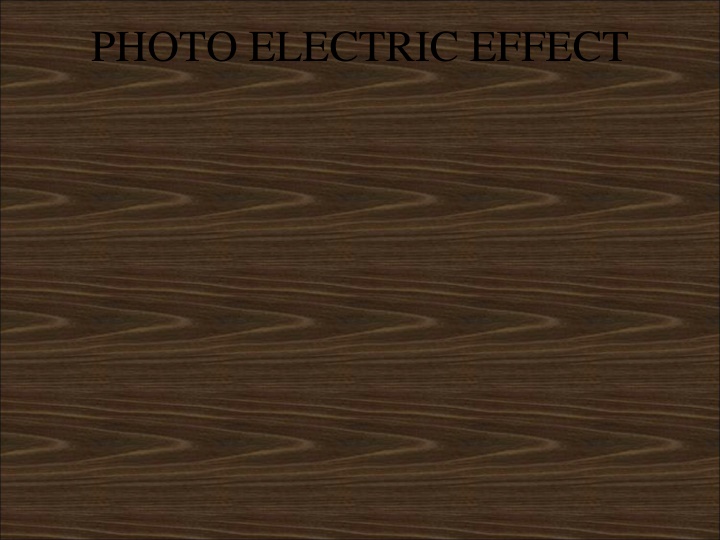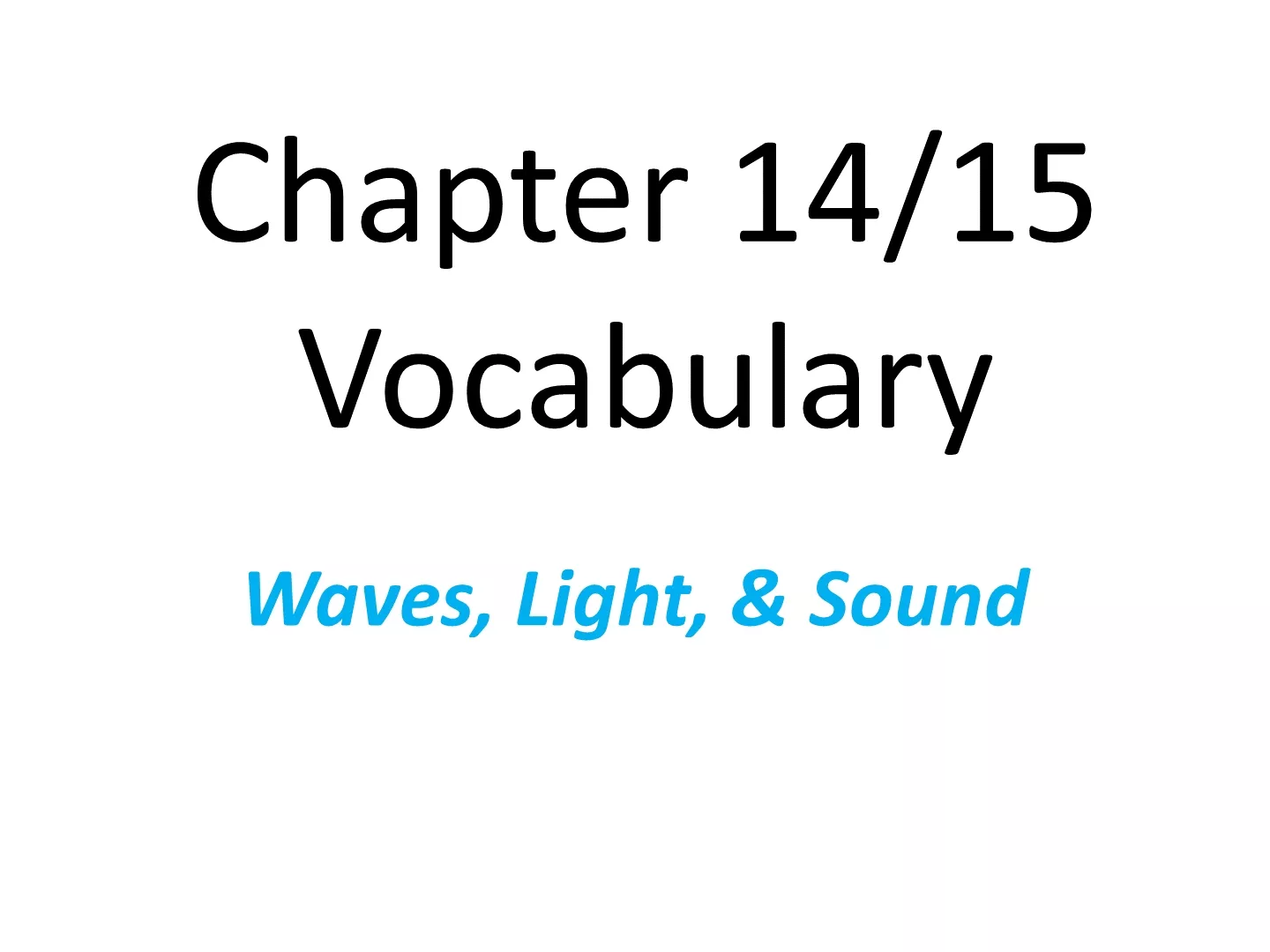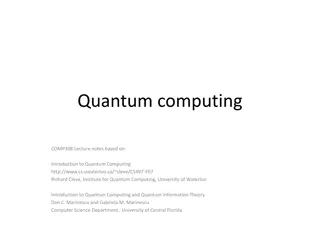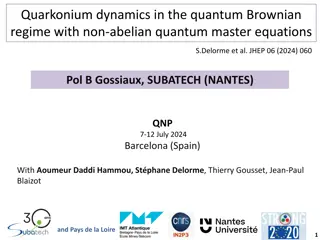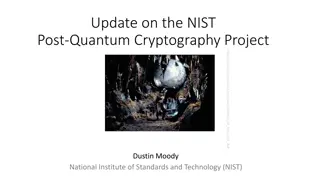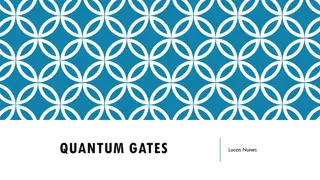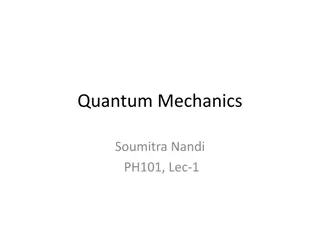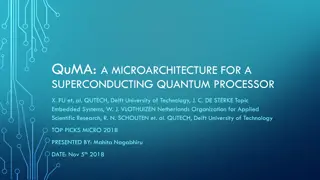Evolution of Light Theory: From Wave Theory to Quantum Theory
At the turn of the century, the discovery of the photoelectric effect challenged the wave theory of light, leading to the development of the quantum theory by Max Planck and Albert Einstein. This new theory introduced the concept of discrete energy units known as quanta, bridging the gap between wave and particle properties of light. The modern understanding views light as radiant energy carried by photons guided by a wave field, highlighting its dual nature. Explore photoelectric emission and the intriguing behaviors of light when interacting with metals.
Download Presentation

Please find below an Image/Link to download the presentation.
The content on the website is provided AS IS for your information and personal use only. It may not be sold, licensed, or shared on other websites without obtaining consent from the author.If you encounter any issues during the download, it is possible that the publisher has removed the file from their server.
You are allowed to download the files provided on this website for personal or commercial use, subject to the condition that they are used lawfully. All files are the property of their respective owners.
The content on the website is provided AS IS for your information and personal use only. It may not be sold, licensed, or shared on other websites without obtaining consent from the author.
E N D
Presentation Transcript
At the end of the century, many physicists felt that all the significant laws of physics had been discovered. Hertz even stated, The wave theory of light is, from the point of view of human beings, a certainty. That view was soon to change. Around 1900, the photoelectric effect was observed. the emission of electrons by a substance when illuminated by e/m radiation Careful study of the photoelectric effect was performed by many scientists.
The wave theory could not totally explain the photoelectric effect, but a variation of the old particle theory could! Max Planck and Albert Einstein subsequently proposed the QUANTUM THEORY. The Quantum Theory The transfer of energy between light radiation and matter occurs in discrete units called quanta, the magnitude of which depends on the frequency of radiation.
Although we still commonly characterize light as a wave, it is actually neither a wave nor a particle. It seems to have characteristics of both. The modern view of the nature of light recognizes the dual character: Light is radiant energy transported in photons that are guided along their path by a wave field.
Photo electric emission In 1902 it was discovered that electrons could be ejected from metals by electromagnetic radiation. Any metal will emit electrons if it is given enough energy.Heated coils in electron guns give of large amounts of electrons.This is called thermionic emission. Philipp Lenard Philipp Lenard
A definition Photoelectric emission is the emission of electrons from the surface of a metal when it is exposed to electromagnetic radiation of sufficient high frequency. Learn this definition
When red light is incident on a clean metal surface: Clean metal surface e e e e e e no electrons are released, however long light is shone onto it, however intense the light source is.
When UV light is incident on a clean metal surface: Clean metal surface e e e e e e e electrons are released instantaneously, however weak the light source.
Classically this cannot be explained because: If red light is shone onto the metal surface for long enough some electrons should gain sufficient energy to enable them to escape.
Einstein put forward a theory: Light energy is quantised. Light consists of a stream of particles called photons. The energy of each photon (E) depends on the frequency (f ) of the light. E = h f
What is h? h is called Planck s constant. h = 6.6 x 10-34Js Max Planck
h is planck's constant red light has a smaller frequency Frequency increasing than violet light
Calculating Frequencies Red light has a wavelength of 640 nm Ultra violet has a wavelength of 2.6 x 10-7m For each of these calculate the frequency.
E = h x f Photon energy Red light photons therefore have less energy than violet light photons and even less than UV photons
Simple questions 1) Blue light has a frequency of 7.7 x 1014Hz while red light has a frequency of 4.3 x 1014Hz.Calculate the energy of a photon of each.
ONE PHOTON GIVES ALL ITS ENERGY e TO ONE ELECTRON
A photon of red light gives an electron insufficient energy to enable it to escape from the surface of the metal. Red light photon Clean metal surface e e surface electrons e e e e e No electrons are released from the metal surface
A photon of UV light gives an electron sufficient energy to enable it to escape from the surface of the metal. UV photon Clean metal surface e e surface electrons e e e e e Electrons are released instantaneously. Each photon releases an electron This is called photoemission.
Laws of Photoelectric emission Observations based on the measurement made of the charge,mass and energy of the emitted electrons lead to the following laws of Photoelectric emission:-
) The number of electrons emitted per second from any given metal is directly proportional to the INTENSITY of the radiation falling on it(Intensity is a measure Of the energy per unit area.In the case of light, it is equivalent to the brightness of the light)
Ii) The photoelectrons are emitted from a given metal with a range of Kinetic energies.from zero up to a maximum.The maximum energy increases with the frequency of the radiation and is independent of the intensity of the radiation.(Shining brighter light of the same colour produces more electrons per second but does not increase their kinetic energies)
For each metal, there is a minimum frequency required to produce emission.This is called the threshold frequency.Radiation below this frequency cannot produce emission, no matter how intense the radiation.
So why is all of this so important? Wave theory of electromagnetic radiation predicts that emission of photoelectrons should happen at all frequencies.Electrons in the metal would absorb energy continuously from radiation of any frequency, and be emitted when they had absorbed enough energy.This process would take longer at lower frequencies but should still happen. Also there should be no maximum kinetic energy of the emitted electrons.
According to wave theory For a particular frequency of light,the energy carried is proportional to the intensity of the beam. The energy carried by the light would be spread evenly over the wavefront. Each free electron on the surface of the metal would gain a bit of energy from each incoming wave. Gradually each electron would gain enough energy to leave the metal
So If the light had a lower frequency(i.e it was carrying less energy) it would take longer for the electrons to gain enough energy but it would eventually happen
The higher the intensity of the wave the more energy it should transfer to each electron so the kinetic energy should increase with the intensity.There is no explanation for the kinetic energy depending only on the frequency.
Photon Model According to the photon model:- When light hits its the metal is bombarded by photons. If one of these photons collides with a free electron the electron will gain energy equal to hf
Why Electron Leaves Before an electron can leave the surface of the metal it needs enough energy to break the bonds holding it there.This energy is called the work function energy and its value depends on the metal.
Threshold frequency If the energy gained from the photon is greater than the work function the electron is emitted. If it isnt the electron will just shake about a bit,then release the energy as another photon.The metal will heat up but no electrons will be emitted.
Maximum kinetic energy The energy transferred to an electron is hf The ke it will be carrying when it leaves the metal is hf minus any energy its lost on the way out(thats why there is a range of ke) The minimum amount of energy it can lose is the work function energy so the maximum kinetic energy is given by the equation hf-work function
Photoelectric equation = + hf KE Energy of incident photon hf Work function KE of freed electron hf = + qV s
Graphical representation h = Vs f q q h = Vs f q q h Frequency = Vs f q q
Summary Light and all forms of electromagnetic radiation is emitted in brief bursts or packets of energy ie it is quantised. The packets of energy which are called PHOTONS travel in one direction only in a straight line. When an atom emits a photon its energy changes by an amount equal to the photon energy The amount of energy contained in each quantum is directly proportional to the frequency f of the radiation.
Negative electroscope White light does not discharge an electroscope UV light does cause discharge - - - - - - - - - - -
Positive Electroscope Any electrons emitted by a positively charged electroscope just get attracted back on to it - + + + + + + + + + + + +
Work function Emission takes place if hf W0 A photon of white light does not contain enough energy to get an electron out of the surface. UV light does have enough energy to get the electron out of the surface If the energy of the photon is greater than W0 then an electron can be emitted. W0
A brighter Light Using a brighter light gives more photons Each photon still has less energy than the work function. The electron can absorb many separate photons but none of them have enough energy to release it W0
Light comes in lumps Light comes in tiny lumps called photons. The energy in one photon depends on the frequency E = hf UV has a higher frequency than white light so one photon contains more energy
Einsteins Photoelectric Equation mv2 = hf Wo If the photon has 8 units of energy, and the work function is 6 then how much energy does the electron have when it gets out. KE = energy given energy used to escape KE = 8 -6 =2 Einstein got a Noble prize for this (8 - 6 = 2) mv2 hf W0
Milikans Photoelectric Experiment How can you measure the KE of an electron if you don t know its speed. Keep increasing the height of the ramp until the ball can t reach the top h is the height that stops the ball PE at top = KE at bottom mgh = mv2 h
Milikans Photoelectric Experiment A slope can stop a ball but what will stop an electron? We use a negative voltage to try and stop the electrons Increase the voltage until it is just enough to stop the electrons (this is called the stopping voltage, Vs) - - - - - - - - - - - - - - - This is a very sensitive ammeter that can detect the flow of electrons Variable voltage supply
Photoelectric equation = = hf = + hf qV s qVs Vs y h f q mx q c = +
Stopping Voltage Vs Energy = charge x voltage mv2 =eVs hf = W0 + mv2 hf = W0 + eVs eVs = hf W0 Vs = (h/e) f W0/e Y = mX + C Gradient = h/e f Threshold frequency (f0) Negative intercept = W0/e Photo effect applet try this!!!
Chapter 18 1 Photoelectric emission: emission of electrons from a surface when illuminated with electromagnetic radiation of sufficient frequency See experiment on page 38 2 Threshold frequency: minimum frequency that will cause photoelectric emission from a material c = f = c/f = 3.0 108 m s 1/(0.88 1015 Hz) = 3.4 10 7 m = 340 nm
3 The larger the wavelength, the lower the photons energy No emission occurs when photon energy is less than the work function Electrons gain energy from an increase in temperature so less energy then required to remove them from the surface (smaller work function) Less energy corresponds to a longer wavelength Visible photon energy is smaller than zinc s work function so no electrons are released It s the individual photon energy that matters, not how many there are
